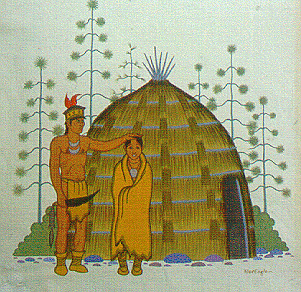Indians Before Europeans
American Indian Perspectives by George Sabo III American Indians have their own perspectives on the past, which include accounts about how their societies were created and how they developed through time. These accounts are very different from the reconstructions offered by archaeologists, historians, and anthropologists, but they are no less important for a comprehensive understanding of Indian history.
The Indians’ own historical perspective is based on stories and ceremonies passed from generation to generation. Modern Indian communities actively maintain some of this information, and texts written after the arrival of Europeans preserve additional material. The temporal framework for this perspective extends from the present back to a time long ago (though not measured in years) when primordial events that formed the present world began to take place. Here we provide a selection of short story versions, from many tribes, that sketch a general outline of Southeastern Indian beliefs about the creation of the world. Origins of the Middle World: Indians of Arkansas and the South live in a three-layer universe. How do Indians account for the origins of this universe? Creation of the World (Osage): According to the Osages, the ancestors came down from the sky. Creation of the World (Caddo): The Caddos believe that a very long time ago, men and animals were brothers and lived together below the ground. Creation of the Sun (Tunica): The Tunicas tell how a beautiful young girl became the sun. The Daughters and the Serpent Monster (Caddo): The Caddos attribute the origins of Above World deities to an event involving a woman, her daughters, and the serpent monster. How Tlanuwa Defeated Uktena (Cherokee): Cherokees tell how Tlanuwa—the great hawks—defeated the winged serpent monster Uktena. Lightning Defeats the Underground Monster (Caddo): The Caddos have another story that tells how Lightning defeated the underground monster. Chaos into Order: How can humans act to defeat the forces that bring chaos into the world? Little Ones Explore the Middle World (Osage): After their descent from the sky, the Little Ones explore the Middle World and organize themselves into the Children of the Middle Waters. Maintaining Order in Osage Communities: Osage village layouts reflect cosmological principles for sustaining order in the Middle World. How People Came to Hunt Animals (Caddo): The Caddos tell how people came to hunt various animals for food. Origins of Corn (Natchez): The Natchez explain why people must work to raise their crops. Origins of Fire (Cherokee): The Cherokees tell how Spider brought fire to the Middle World. Natchez Sacred Fire: The Natchez point out the consequences of carelessness. Understanding the World Through Stories: How story telling is used to maintain the sacred history of Southeastern Indians. |
||
 |

|
